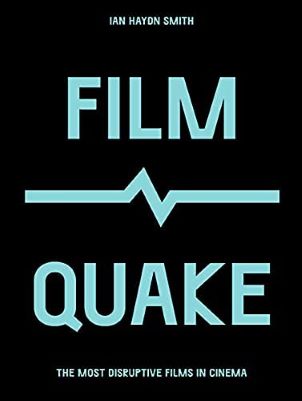CELLULOID CULTURE SHIFTERS
In his recent history, A Chronology of Film, Ian Haydn Smith brilliantly gave us a wide-ranging picture of worldwide cinematic development from its inception until the present day. In his new book FilmQuake: The Most Disruptive Films in Cinema he sets himself an even more daunting task; he limits himself to examining fifty of the thousands of films made in the past 120 years to illustrate the influence of film on the social, cultural and political changes across that period of time.
Smith has organized the book in five clearly defined sections, each covering approximately a couple of decades. The format and layout are extremely attractive, filled with well-chosen stills guaranteed to lure the reader into sampling the text. The result is a sort of guide book, allowing the reader to linger or move on as he pleases.
Representative lists in the arts are always a tricky proposition. No sooner is a compilation of the fifty “most influential” novels, record albums, or pizza joints published than a dozen people come up with an alternate, and in their opinion, more valid fifty.
Of Mr. Smith’s selections I have to confess to having seen only about half — and I like to think of myself as a movie buff! His list is an eclectic mix of the familiar, the less-so, and the downright obscure. However, his choices are probably as valid as any other — definitely representative of the time and place in which they appeared, and emblematic of future trends.
Dziga Vertov’s camera eye in Man with a Movie Camera (1929) presented a radical interpretation between film-maker and viewer
The films can be neatly divided into two broad categories — technical innovation and innovation of subject matter. Pretty much every genre is represented, from the Lumière brothers’ famous Arrival of a Train to Spielberg’s Jaws.
There are of course the expected choices; Battleship Potemkin, Psycho, Citizen Kane, The Seventh Seal. These would be on anyone’s list. Surprisingly there’s only one comedy (Some Like It Hot); a curious omission considering the influence the screwball comedies of the thirties had on relations between the sexes.
Each of the book’s five sections approximate to a recognizable period of time. Smith includes a timeline at the head of each section, detailing significant political and cultural events giving us historical context to the films described. The first section, “The Shock of the New”, takes us from 1895 to the coming of sound. One of the pivotal events of this period was the release of D.W. Griffith’s Birth of a Nation, which showed the enormous strides film had taken in the twenty years from its modest store-front beginnings. Its technical influence was enormous, its impact on race relations disastrous.
The most famous scene in An Andalusian Dog was based on a dream Buñuel recounted to Dalí and their film developed from there
The second section deals with the advent of the talkies and the rise of nationalist cinema in Italy, Germany and Japan. The political impact of cinema had already been exploited in the Soviet Union and was employed to malign effect in Nazi Germany. In America the initially derided Citizen Kane had an influence on every aspect of production which is still felt.
The sixties saw the coming of the New Wave in Europe which gave rise to the international art house movement. By the 1980s, the counter culture had been embraced by the mainstream and the age of the blockbuster was upon us. In his final section Smith touches on the various new platforms that have emerged in the last twenty years and leaves us with the open ended question, “What comes next?”
Satyajit Ray’s film shone a light on an area of Indian society previously neglected on film
The extent to which many of these films actually influenced subsequent filmmakers is debatable. For example, Psycho — surely the best-known film on the entire list — didn’t spawn a series of films killing off their leading lady at the end of the first act, and Jaws told us something most of us already knew — swimming with sharks is a bad idea.
The unassailable fact is that from the fifties onwards, television has had a far more wide-ranging impact than cinema. In a show like Will and Grace, the oft-despised genre of sit-com has probably done more to further acceptance of homosexuality than any film since Victim (1961).
But as Smith points out in his final summing up: even broadcast television has been supplanted by the various streaming platforms, giving unrivalled access to filmmakers’ work from any time in the last hundred plus years. Smith takes us on a joyous, sometimes scary ride, and it’s not over yet.
FilmQuake: The Most Disruptive Films in Cinema
Ian Hadyn Smith
publishing September 21, 2021 by Frances Lincoln
English | paperback | 208 pages
$16.99 USD, $22.99 CAN ∙ ISBN: 9780711259713

